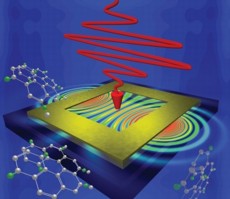Science
Researchers Report Novel Approach for Single Molecule Electronic DNA Sequencing

Schematic of single molecule DNA sequencing by a nanopore with phosphate-tagged nucleotides. Each of the four nucleotides will carry a different tag. During SBS, these tags, attached via the terminal-phosphate of the nucleotide, will be released into the nanopore one at a time where they will produce unique current blockade signatures for sequence determination. A large array of such nanopores will lead to high throughput DNA sequencing.
- Read more
- 366 reads
Ultra fast optical amplifier: silicon and erbium on one chip for the first time

Image of the chip including silicon optical waveguide (SOI: silicon on insulator) as well as erbium-doped aluminium oxyde.
- Read more
- 391 reads
Mystery Spheres on Mars

Using its Microscopic Imager, Opportunity photographed these small spherical objects on Sept. 6, 2012. The view covers an area about 2.4 inches across at an outcrop called "Kirkwood" on the western rim of Endeavour Crater.
- Read more
- 399 reads
Optical Waveguide Connects Semiconductor Chips

The wire bond is adapted to the position and orientation of the chips.
- Read more
- 379 reads
The search for new materials for hydrogen storage

Four types of materials studied in the dissertation: fullerene C60, carbon nanotubes, metal-organic frameworks (MOFs), and fullerene C60 encapsulated inside carbon nanotubes.
- Read more
- 435 reads
NASA Mars Rover Targets Unusual Rock on Its Journey

The drive by NASA's Mars rover Curiosity during the mission's 43rd Martian day, or sol, (Sept. 19, 2012) ended with this rock about 8 feet (2.5 meters) in front of the rover.
- Read more
- 376 reads
Photocatalysis as an energy source: Zn-Ga-O nanocubes improve conversion rate

Chinese researchers have developed a new nanomaterial to improve the chemical conversion rate in photocatalytic energy systems.
- Read more
- 433 reads
Near-Field Enhancements along Ring-Shaped Nanostructures

The near-field enhancement on the surface of ring-shaped gold nanostructure becomes homogeneous through circularly polarized light.
- Read more
- 553 reads
Dawn Sees Hydrated Minerals on Giant Asteroid

Pitted Terrain in Color
These enhanced-color views from NASA's Dawn mission show an unusual "pitted terrain" on the floors of the craters named Marcia (left) and Cornelia (right) on the giant asteroid Vesta.
- Read more
- 378 reads
NASA's Solar Fleet Peers Into Coronal Cavities

Scientists want to understand what causes giant explosions in the sun's atmosphere, the corona, such as this one. The eruptions are called coronal mass ejections or CMEs and they can travel toward Earth to disrupt human technologies in space. To better understand the forces at work, a team of researchers used NASA data to study a precursor of CMEs called coronal cavities.
- Read more
- 374 reads
Human Rights
Fostering a More Humane World: The 28th Eurasian Economic Summi

Conscience, Hope, and Action: Keys to Global Peace and Sustainability

Ringing FOWPAL’s Peace Bell for the World:Nobel Peace Prize Laureates’ Visions and Actions

Protecting the World’s Cultural Diversity for a Sustainable Future

Puppet Show I International Friendship Day 2020

